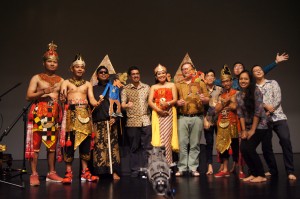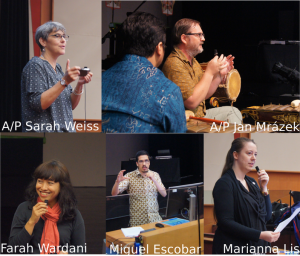
A hundred and fifty people attended the launch of the Contemporary Wayang Archive (CWA) in Lecture Theatre 13 on 7 October.
The archive is the work of Dr. Miguel Escobar Varela, an Assistant Professor of Theatre Studies in the Department of English Language and Literature. It contains video recordings of 24 performances, along with scripts, translations into English and Indonesian (if the script is Javanese), notes and details of honorifics. Together, the videos and supporting apparatus make this modern and popular performance form available to a worldwide audience.
Wayang is, Associate Professor Sarah Weiss of Yale-NUS College explained at the launch, a kind of “Gesamtkunstwerk”—a form that brings different arts together. It incorporates puppetry, dialogue, dance and music and has often assimilated new cultural influences from other places. Associate Professor Jan Mrázek of Southeast Asian Studies, gave a more personal account of his encounters with Wayang, and what it has meant to him. He first saw a performance as a teenager visiting the US from communist Czechoslovakia. The sense of dislocation he experienced then has remained with him ever since, and continues to shape his understanding of a form that “has defined my life”, as he confessed.
But if Wayang dislocates, it also brings people together. Farah Wardani, former Executive Director of the Indonesian Visual Art Archive, spoke of her institution’s collaboration with Dr. Escobar. CWA, she said, had been built upon friendship, a quality that was evident throughout the launch. The speakers and performers played their parts with the energy and enthusiasm of friends working together.
The launch culminated in an electrifying performance of “Wayang Hiphop.” It was led by the Dalang, Catur “Benyek” Kuncoro, and four members of his troupe (a DJ and three singers), and supported by FASS’s Singa Nglaras Gamelan Ensemble. The performance began with traditional puppets casting shadows across the back of the stage, to the sounds of gamelan music.
But this was soon interrupted by the eruption onstage of three of Dalang Benyek’s troupe. Dressed in traditional Wayang Wong costume, with the addition of very modern footwear, they rapped to electric beats complemented by the gamelan ensemble. Their music was a powerful mixture of street rhythms originating from the US with melodies and poetry from Java. In the puppetry that followed, modern versions of the punokawan (the clown-servants of Wayang) joked about the appearance on their puppet laptop of the CWA.

The launch was very different from the sobriety of most academic events. But there was serious academic work behind it. Wayang is one of Southeast Asia’s most important traditional performance forms. It has undergone many changes in its history, and the emergence of Wayang Kontemporer represents a new and significant development. The archive preserves and disseminates knowledge of this development for scholars and students everywhere.
